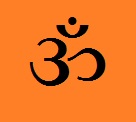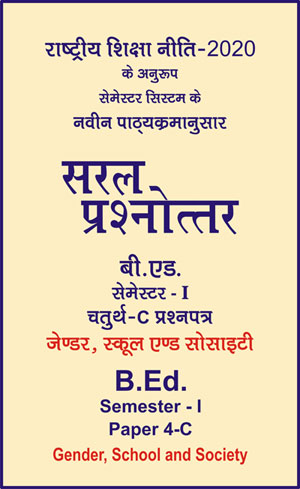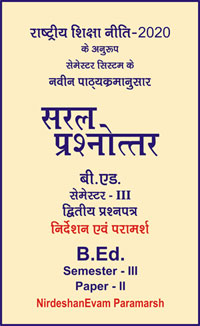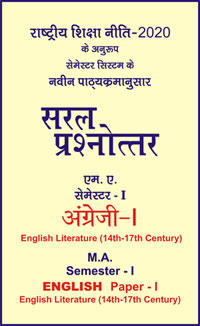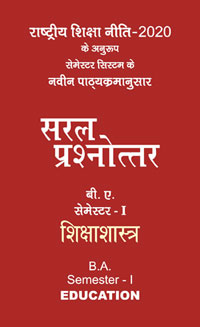|
बी एड - एम एड >> बी.एड. सेमेस्टर-1 प्रश्नपत्र-IV-C - जेण्डर, स्कूल एण्ड सोसाइटी बी.एड. सेमेस्टर-1 प्रश्नपत्र-IV-C - जेण्डर, स्कूल एण्ड सोसाइटीसरल प्रश्नोत्तर समूह
|
|
||||||
बी.एड. सेमेस्टर-1 प्रश्नपत्र-IV-C - जेण्डर, स्कूल एण्ड सोसाइटी (अंग्रेजी भाषाा में)
Objective Type Questions
Note : Select the correct option.
-
The implementation of reservations generates interest among the concerned masses in ________
(a) society
(b) politics
(c) family
(d) entertainment. -
When did Pratibha Patil make the announcement regarding the issue of reservation?
(a) June 4, 2009
(b) June 5, 2009
(c) June 6, 2009
(d) June 7, 2009. -
According to the President, women have to be deprived of what?
(a) Class
(b) Caste
(c) Opportunity
(d) All of these. -
Women’s empowerment has now become a reality of .......... Lok Sabha.
(a) 10th
(b) 12th
(c) 15th
(d) 17th. -
What percentage of reservation was demanded for women in Parliament and Legislature?
(a) 30
(b) 33
(c) 35
(d) 38. -
Whose unmatched example do women put in front of the world?
(a) renunciation
(b) surrender
(c) recycling of resources
(d) were all. -
When was the issue of political representation of women first raised?
(a) 1951
(b) 1961
(c) 1971
(d) 1981. -
In whose report, the option of reservation for women was first seen?
(a) Mahatma Gandhi
(b) Jawaharlal Nehru
(c) Kaka Kalelkar
(d) Dr. Bhimrao Ambedkar. -
When did the discussion on women’s reservation actually start?
(a) 1991
(b) 1992
(c) 1993
(d) 1994. -
When is International Women’s Day celebrated?
(a) 8th March
(b) 8th May
(c) 8th June
(d) 8th October. -
When did the government adopt ‘Women’s Welfare Policy’ to remove gender based differences?
(a) 1935
(b) 1953
(c) 1967
(d) 1976
-
Who was elected as the first woman member in the central legislature?
(a) Sarojini Naidu
(b) Renuka Rai
(c) Indira Gandhi
(d) Pratibha Patil. -
Article-15 (1) of the Constitution is related to :
(a) religion, place of birth
(b) ancestry
(c) caste-gender
(d) all of the above. -
In which area have women got reservation so far?
(a) Lok Sabha
(b) Vidhansabha
(c) Panchayats
(d) Everywhere. -
In which states, the government has provided 50 percent reservation to women in Panchayats?
(a) Bihar
(b) Himachal Pradesh
(c) Madhya Pradesh
(d) All of these. -
What is the real achievement of women empowerment?
(a) She should be proud of her complete womanhood
(b) Infuse confidence in herself
(c) Have the courage to live on her own terms
(d) All of the above. -
It is more important than reservation that women should :
(a) empower themselves
(b) not weaken in confidence
(c) prepare them for the fight for their rights
(d) all of the above. -
Which people have to face discrimination throughout their life?
(a) men
(b) women
(c) transgenders
(d) all. -
Who has recognized transgender persons as third gender?
(a) Society
(b) Supreme Court
(c) Leaders
(d) Parliament. -
Where did the Supreme Court allow transgender persons to enter?
(a) in educational institutions
(b) in workplaces
(c) in politics
(d) everywhere. -
Under which article did the court provide equal rights and protection to transgender persons?
(a) Article 14
(b) Article-15
(c) Article 21
(d) All of the above. -
By which article, the court protects gender expression?
(a) 19 (1 - a)
(b) 19 (2 - a)
(c) 20 (1 - a)
(d) 20 (2 - a). -
Which documents have been recognized by the Supreme Court for the third category (transgender)?
(a) Passport
(b) Ration Card
(c) Driving License
(d) All of these.
-
Article 16 deals with which right?
(a) Equality
(b) Security
(c) Employment
(d) Education. -
In which area of life, transgender persons had to face the most problems before the court’s decision?
(a) housing
(b) health
(c) education and employment
(d) all of the above. -
Which of the following commissions has recommended “Purdah Schools” for girls?
(a) The Indian Education Commission
(b) The Calcutta University Commission
(c) Kothari Commission
(d) Radhakrishanan Commission -
In which year was the Ministry of Women and Child Development established as a department under the Ministry of Human Resource Development?
(a) 1980
(b) 1986
(c) 1985
(d) 1988 -
Self-Employed Women’s Association (SEWA) was founded by :
(a) Vandana Shiva
(b) Medha Patka
(c) Bhikaji Kaama
(d) Ela Bhatt -
Prenatal Diagnostic Testing was banned in the year :
(a) 1956
(b) 1958
(c) 1994
(d) 1995 -
Section 326-A is a related with :
(a) Pre-Diagnostic Natal Test
(b) Attempted to acid attack
(c) Acid attack
(d) Cyber crime -
To help the widows, by whom the Hindu widow home established in 1893 ?
(a) Justice Mahadev Ranade
(b) Dhondo Keshav Karve
(c) Ishwarchandra Vidyasagar
(d) Swami Dayanand Saraswati -
What is UDAN Programme?
(a) It is the enrollment scheme of girl students in prestigious engineering institutions.
(b) It is the enrollment scheme of girl in primary school.
(c) It is the enrollment scheme of boys and girls in primary school.
(d) It is the Scholarships scheme for girls. -
Who was the first Indian woman to reach the rank Lieutenant General in the Indian Army?
(a) Punita Arora
(b) Punita Khanna
(c) Arati Saha
(d) Roshini Sharma
-
Which of the committee gave suggestion that “State Councils of Women’s Education should be established in each state”?
(a) Durgabhai Deshmukh Committee
(b) Hansa Mehta Committee
(c) Acharya Narendradev Committee
(d) Rammurti Committee -
Which articles of the constitution highlight the right to equality?
(a) Article 14
(b) Article 15
(c) Article 16
(d) All of the above -
Which Article of the Constitution of India ends untouchability?
(a) Article 14
(b) Article 17
(c) Article 18
(d) All of the above -
For whom did Raja Ram Mohan Roy fight?
(a) Improving the status of women
(b) End of sati practice
(c) Remove superstition, social inequality and illiteracy
(d) All of the above -
Feminism is a ............. .
(a) Awareness of Women
(b) Emotion of Women
(c) Love of Women
(d) Anger of Women -
According to Census 2011, what is the child sex ratio of India?
(a) 950/1000
(b) 973/1000
(c) 980/1000
(d) 875/1000 -
Which Commission / Policy paid special attention to gender issues in education?
(a) Kothari Commission
(b) Radhakrishanan Commission
(c) National Education Policy - 1986
(d) Durgabai Deshmukh Commission -
Who is the first judge of Supreme Court of India?
(a) Justice Ruhana Begam
(b) Justice Fatima Beevi
(c) Justice Sukhvindar Kaur
(d) Justice Lakshmi Nayyar -
The condition of women is pathetic even today:
(a) In rural areas
(b) In urban areas
(c) In both the above areas
(d) None of the above -
Which one of the following is not a scheme or program related to women empowerment?
(a) S.S.A.
(b) Ladali
(c) Ladoshree
(d) Kasturba Gandhi -
Who worked very hard for stop the practice of Sati?
(a) Vivekanand
(b) Raja Ram Mohan Roy
(c) Swami Dayanand Saraswati
(d) Bhimsen
-
Which commission constituted the national commission for women as statutory body?
(a) The National Commission for Women Act, 1990
(b) The National Commission for Women Act, 1991
(c) The National Commission for Women Act, 1992
(d) The National Commission -
An umbrella term for people whose gender identity does not match the sex they were assigned at birth:
(a) Cisgender
(b) Transgender
(c) Heterosexual
(d) Sex -
Section 375 of the Indian penal code, 1860 states which law:
(a) Law related to dowry
(b) Law related to divorce
(c) Law related to rape
(d) Law related to exploitation -
Dowry prohibition act came in which year?
(a) 1961
(b) 1963
(c) 1965
(d) 1968 -
Which of the following countries has seen significant improvement in women’s right over the last several decades?
(a) Brazil
(b) Iran
(c) Saudi Arabia
(d) None of the above
|
|||||

 i
i 
